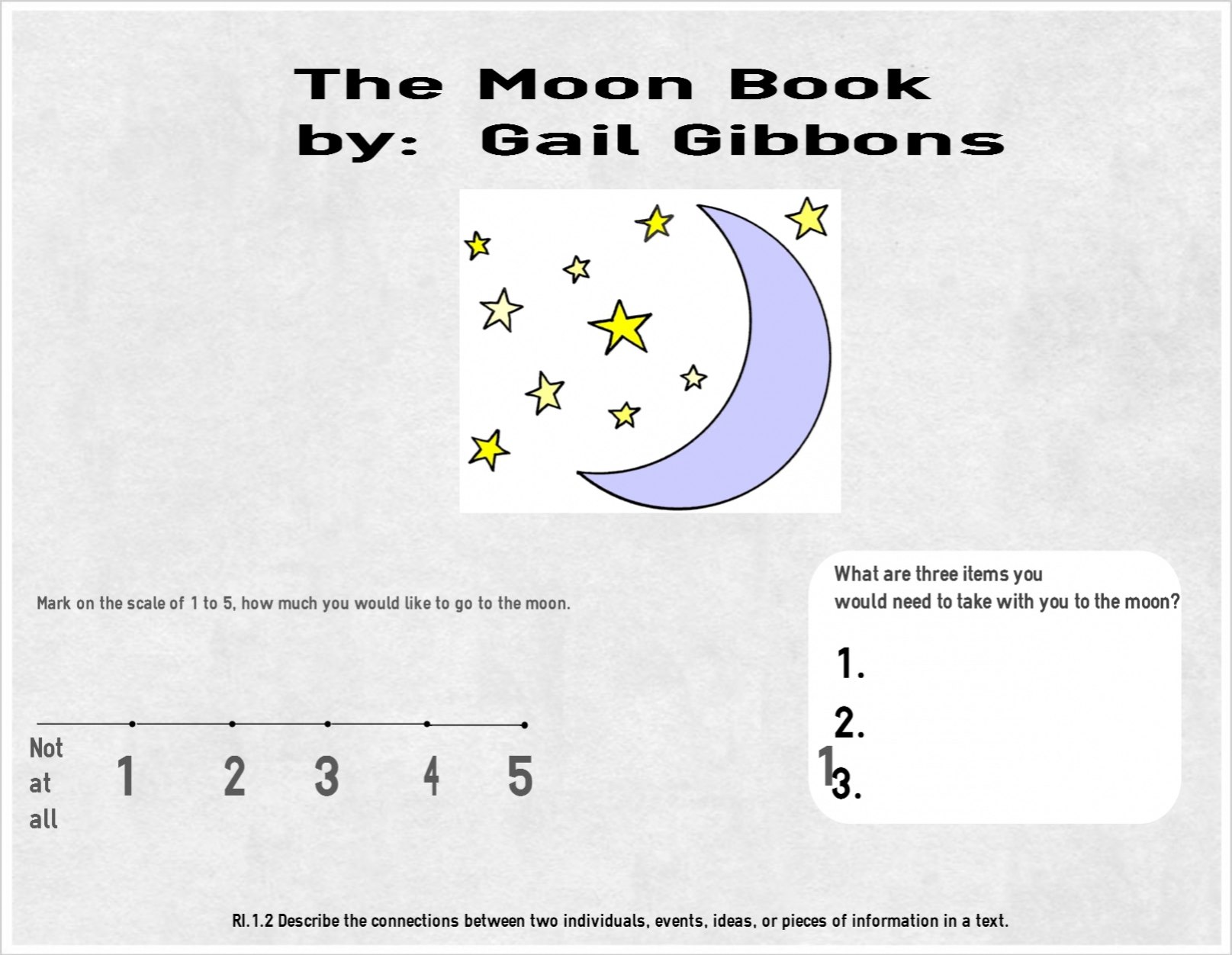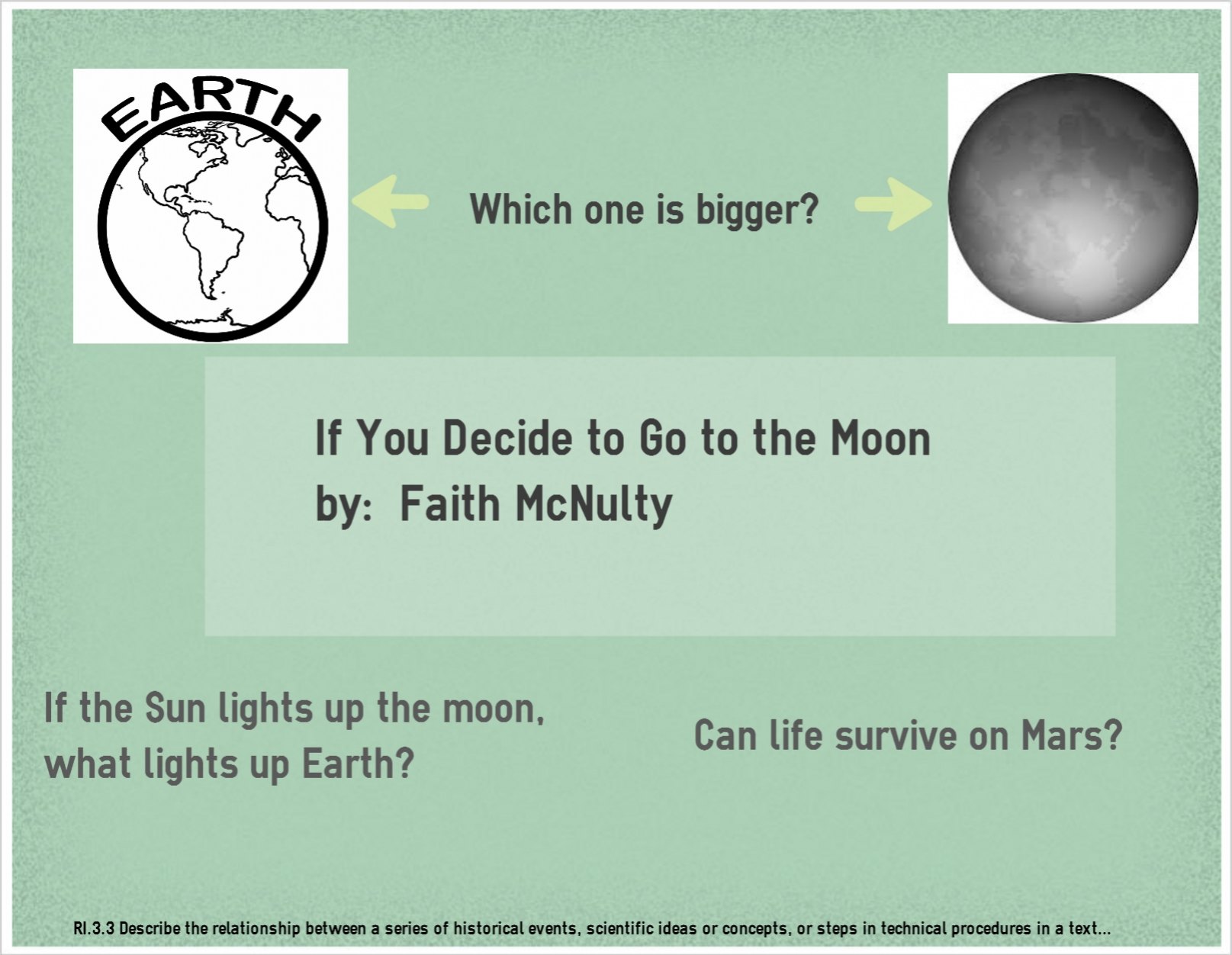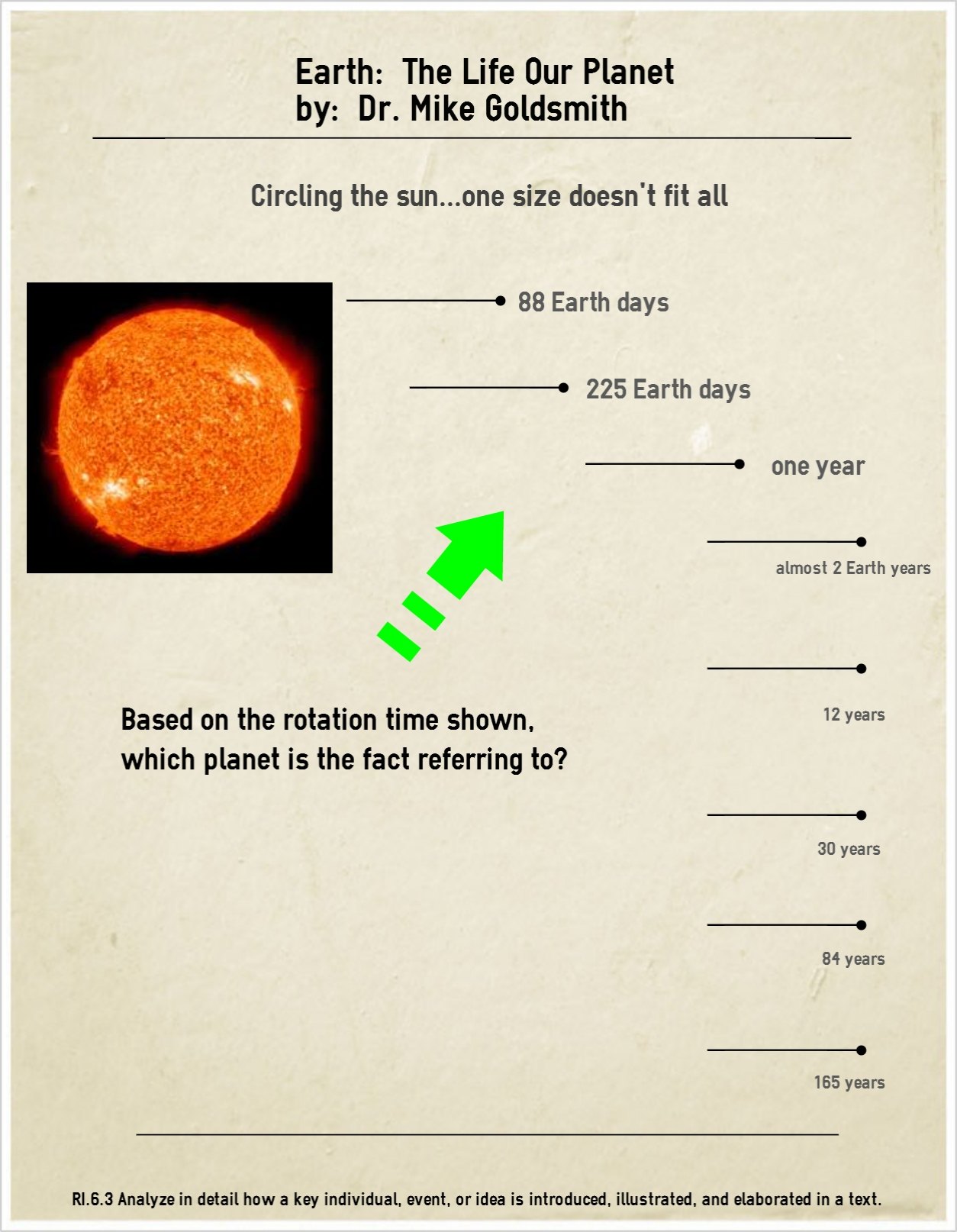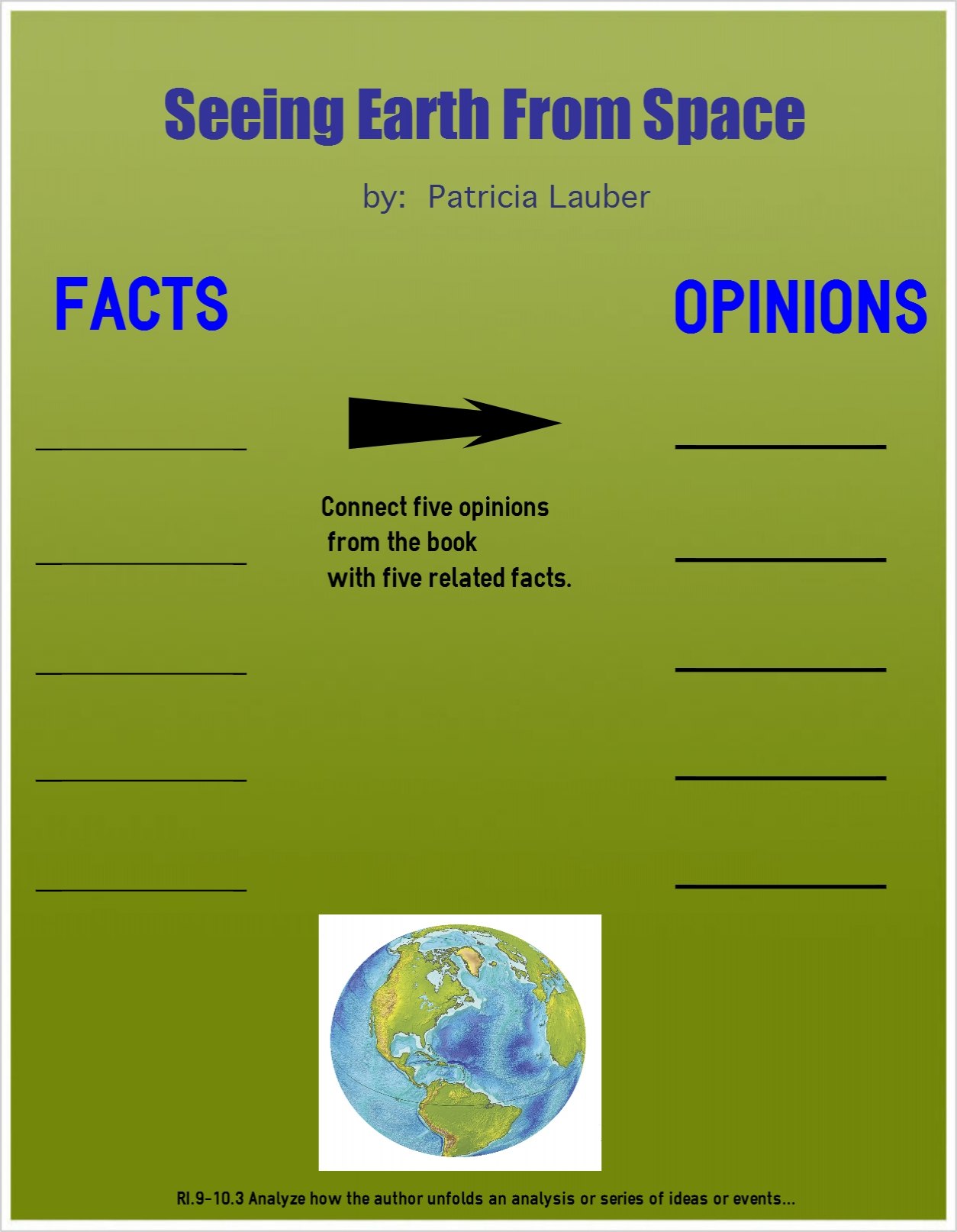Key ideas and details are important to forming a solid foundation related to informational writing. This week, we are focusing on the final information standard in the Key Ideas and Details section of the ELA Common Core Standards. As students explore this standard, they must become familiar with making connections between what they read in one location with knowledge that they obtain in related areas.
This week we are excited to suggest a number of activities that relate to the solar system with a clear emphasis on Reading Information standard 3. Let’s move ahead to review the standards for Kindergarten through second grade.
Kindergarten – 2nd grade teachers:
- CCSS.ELA-Literacy.RI.K.3 With prompting and support, describe the connection between two individuals, events, ideas, or pieces of information in a text.
- CCSS.ELA-Literacy.RI.1.3 Describe the connection between two individuals, events, ideas, or pieces of information in a text.
- CCSS.ELA-Literacy.RI.2.3 Describe the connection between a series of historical events, scientific ideas or concepts, or steps in technical procedures in a text.
This week’s first grade lesson is centered on The Moon Book by Gail Gibbons. Students are asked to reflect on their own desire to travel to the moon. This vheme provides students the opportunity to personalize the book’s content, as they rank their desire to travel to the moon on a scale of 1 to 5. Additionally, they continue to make a connection between the idea of traveling to the moon with their own personal needs. Undoubtedly, students will make a personal connection with The Moon Book after using this interactive graphic organizer.

Other extension ideas related to this picture book:
- Create a vheme that allows students to reflect on why the moon appears to change shapes.
3rd – 5th grade teachers:
Third grade students will also have a chance to apply the Reading Information Standard 3 to their exposure to the moon using the vheme available located here.

After reading If You Decide to Go to the Moon by Faith McNulty, students will directly explore the following ELA Common Core Standards. Please note that while this activity does not specifically align to the fourth and fifth grade standards, minor adjustments would allow this vheme to be paired with these intermediate grades too.
- CCSS.ELA-Literacy.RI.3.3 Describe the relationship between a series of historical events, scientific ideas or concepts, or steps in technical procedures in a text, using language that pertains to time, sequence, and cause/effect.
- CCSS.ELA-Literacy.RI.4.3 Explain events, procedures, ideas, or concepts in a historical, scientific, or technical text, including what happened and why, based on specific information in the text.
- CCSS.ELA-Literacy.RI.5.3 Explain the relationships or interactions between two or more individuals, events, ideas, or concepts in a historical, scientific, or technical text based on specific information in the text.
McNulty does a fantastic job of presenting the relationship between the sun, the moon, and Earth. This colorful interactive organizer challenges students to reflect on these concepts that are presented in the technical text. Additional questions encourage students to recall other technical information about the life, as it relates to the moon.
Other extension ideas related to this picture book:
- Design a vheme to illustrate the moon, sun, and Earth’s relationship.
- Create a vheme to show the protective gear needed to visit the moon.
6th – 8th grade teachers:
The following sixth grade pre- and post-reading activities challenges students to analyze the planets’ rotation around the sun, as it relates to distance and temperatures. . Specifically, the following standards show how key details and ideas expressed in nonfiction books are critical to understanding the concepts presented in Elaine Scott’s When is a Planet Not a Planet?
- CCSS.ELA-Literacy.RI.6.3 Analyze in detail how a key individual, event, or idea is introduced, illustrated, and elaborated in a text (e.g., through examples or anecdotes).
- CCSS.ELA-Literacy.RI.7.3 Analyze the interactions between individuals, events, and ideas in a text (e.g., how ideas influence individuals or events, or how individuals influence ideas or events).
- CCSS.ELA-Literacy.RI.8.3 Analyze how a text makes connections among and distinctions between individuals, ideas, or events (e.g., through comparisons, analogies, or categories).
Teachers can definitely make use of this vheme to determine how familiar students are with the planets’ locations from the sun. Following reading, the same vheme can be used to compare students’ pre-reading knowledge with their post-reading understanding.

Other extension ideas related to this picture book:
- Design a vheme to show the location of the planets.
- Design a vheme to show the temperatures of the planets.
9th – 12th grade teachers
Reading high school level nonfiction texts creates elaboration and technical elements that may be confusing to readers. They need to be encouraged to analyze complex ideas to see how the varying information works together to create one central idea. The following high school ELA Common Core Standards require these reading skills to be taught:
- CCSS.ELA-Literacy.RI.9-10.3 Analyze how the author unfolds an analysis or series of ideas or events, including the order in which the points are made, how they are introduced and developed, and the connections that are drawn between them.
- CCSS.ELA-Literacy.RI.11-12.3 Analyze a complex set of ideas or sequence of events and explain how specific individuals, ideas, or events interact and develop over the course of the text.
Patricia Lauber’s Seeing Earth From Space” combines engaging photography with facts and opinions to create a strong connection to astronaut travel and personal perspective. As students consider the author’s use of facts and opinions, they become aware of how these varying detail types are used to build on the complex idea of an astronaut’s perspective.

Other extension ideas related to this picture book:
- Create a vheme on Easel.ly to serve as a photo essay relate to how a civilian might view Earth from outer space.
Final Notes:
Before students can become pros at reading informational literature to discern an author’s craft and structure, they must first demonstrate proficiency in how a text relates to key details and ideas. The activities provided this week, as well as throughout the previous weeks provide enriching lessons that engage students in reading a variety of materials that are assessed using a number of formative assessment types. Next week, we will be taking a closer look at Reading Literature Standard 4, the first standard in the Craft and Structure of the ELA Common Core Standards. Until then, may all your vhemes be made easily at Easelly.